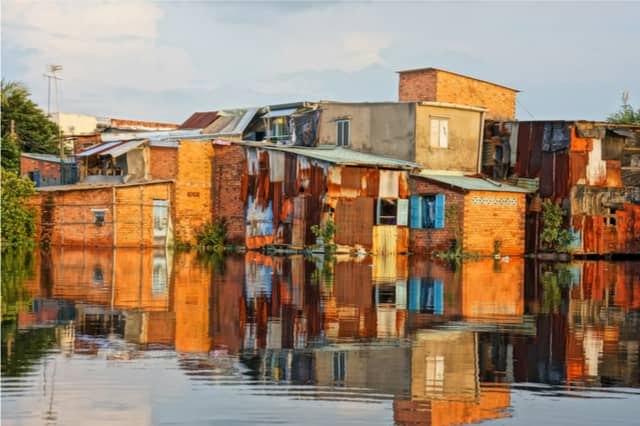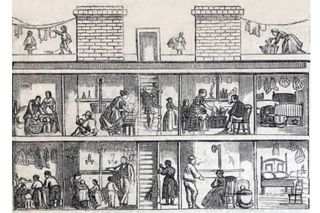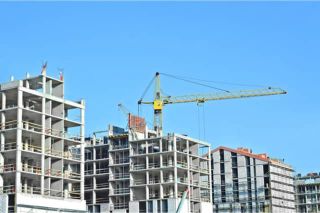
www.buildingsandcities.org/insights/commentaries/cop26-cities5.html
COP26 & Beyond: What Role for Cities?

Were the needs and demands of cities and local governments marginalised in their roles and representation at COP26?
The 26th UNFCCC
Conference of Parties (COP26) in Glasgow represented a decisive moment in
history. Five years after Paris, it was a moment of reckoning - had countries
delivered on their promises? It was also the last chance for political leaders
to raise GHG reduction targets to prevent global warming above 1.5 oC. Linda Westman (University of Sheffield) reflects on COP26 and the prospects for cities and local governments.
The discursive landscape of the COPs
The Conference of Parties (COPs) constitute an arena for intergovernmental negotiations, where 'parties' (nation states) seek to form an agreement on global warming. However, the events also function as platforms for broader political contestation. The conferences involve a flurry of activities - side events, capacity building meetings, pavilions - occurring in parallel with the negotiations. Many groups with an interest in climate change (NGOs, youth movements, trade unions, etc.) participate in the COPs.
The discourses that circulate at the COPs reflect the frontier of climate politics, in terms of strategies, visions, and points of conflict. Three discourses - green governmentality, ecological modernization, and civic environmentalism - which dominated previous conferences (Bäckstrand and Lövbrand 2019) also permeated COP26. The green governmentality discourse, focused on administrative rationalism and state-led resource management, has persisted since the establishment of the UNFCCC. In Glasgow, the focus on global tipping points and emission trajectories contributed to a revival of interest in coordinated international action. At the same time, COP26 side events strongly reflected ecological modernization discourse, emphasizing partnerships, corporate leadership, and technology. While carbon markets no longer dominate the debate, there is a pervasive interest in mobilizing private financing, especially to bridge the 'adaptation gap' (UNEP 2021). The civic environmentalism discourse, which represents a system-critical alternative, featured through sessions focused on youth, climate justice, indigenous rights, and gender equality. Social movements also advocated these concerns through protests on the side lines of the program. At the People's Plenary held on the last day of the COP, civil society constituencies decried the exclusionary character of the negotiations and the inability of UNFCCC processes to tackle structural injustice.
Giving cities a seat at the table?
Cities faced a challenge in navigating this fragmented landscape. Local authorities always held an ambiguous position within UNFCCC platforms. They are not non-governmental organizations, yet are represented by one of the official non-state constituencies: Local Governments and Municipal Authorities (LGMA). The LGMA fought hard to achieve recognition as a 'government' stakeholder, yet their advocacy is often directed towards their own national governments. This situation is unique among constituencies and brings unique difficulties.
Regarding political struggles surrounding the formal negotiations, cities did not have an easy time in Glasgow. The LGMA constituency, coordinated since the 1990s by ICLEI, has consistently advocated for recognition in the international agreements and access to the negotiating table. They have reached many successes, including the inclusion of subnational governments in the Paris Agreement. Since the adoption of a Local Government Climate Roadmap in 2007 and the recognition of non-state actors in at COP17 in Durban in 2011, urban areas attracted increasing attention. However, at COP25 in Madrid, local representatives showed concern that this wave was ebbing. This sentiment accumulated into disappointment at COP26, as cities hardly reached consistent visibility throughout the conference.
The LGMA constituency, promoting events through their own pavilion at COP26, nevertheless continued their tireless campaign. This year, the advocacy concentrated around the struggle to include 'multilevel collaboration' in the Glasgow Climate Pact. This work resulted in success (UNFCCC 2021), but the fight raised the question why the UK Presidency had not incorporated subnational perspectives in the first place. Hypotheses included a lack of awareness of urban concerns among ministers at the COP (a long-standing problem), unfavourable party politics, or attempts to bring large emitters with centralized political systems (e.g. China, Russia) on-board by downplaying subnational concerns. In either case, local representatives expressed the need to create better access to national and international finance, in particular to meet the costs of adaptation. This gap is especially acute in small cities in the Global South, largely overlooked at COP26. As stated by a representative from Rwanda, "local governments are like mothers: they know how to take care of their baby, but they sometimes don't have the resources to feed it".
Win-win solutions in urban areas
In sessions dominated by ecological modernization discourse, synergies emerged between innovation and urban development. Several high-level meetings with a focus on urban areas were arranged on 'cities day' on 11 November, which had a built environment theme. These sessions demonstrated close connections between industrial development and urban climate action. For example, a representative of Oslo described their promotion of clean construction equipment, illustrating how public procurement can shape global supply chains. A similar approach was visible in an Action Hub session arranged by C40, showcasing solutions for clean construction. Many other sessions highlighted opportunities of technology development in cities. For instance, a session on urban living labs stressed the transformative potential of innovation in cities, highlighting opportunities linked with electric vehicles, micro grids, and energy storage systems. The Chair of the UK-based Local Government Association (LGA) framed climate change as a green industrial revolution, in which councils compete to attract sustainable business. These side events capture the effective translation of win-win rationales and market-based action into urban climate policy.
Climate justice as a concern for cities
Among communities advancing narratives of civic environmentalism, the presence of cities was less evident. Overall, side events on climate justice displayed a limited engagement with urban issues. Some local officials described a feeling of being 'wiped out by the youth-wave', as the strong interest in other non-state actors occurred alongside the relative disengagement with cities.
Yet, many events also illustrated that the separation of justice from the urban is untenable. Local governments showed how their climate programmes are inseparable from the issues of equity and social wellbeing. For example, a local official from the Bay Area in California, US, explained that their history of slavery and racist policy directly shape patterns of spatial and economic inequality. Climate interventions must address such injustice, whether by making sure that income from climate programs is directed to disadvantaged communities or that energy retrofits do not price anyone out of their homes. Many local officials presented similar concerns, emphasizing that poor communities are affected most by climate impacts and that residents must be engaged in dialogue when decisions are made. These experiences are captured in the literature on climate justice, which explains how inequality is embedded in built environments and how policy and planning in cities can address climate justice concerns (Klinsky and Mavrogianni 2020).
The road to COP27
The core mission of COP26, to keep the 1.5 oC target alive, was left on 'life support' at the end of the conference, according to UN Secretary-General António Guterres. What prospects, then, are left for the multilateral system in COP27 in Egypt?
One reassuring message from local leaders in Glasgow is that, regardless of the resolutions of COP26, their work will continue. As observed by Patrick Harvie, First Minister for zero carbon buildings of Scotland, "whatever the headlines, it is the cities that need to crack on and get the job done". Local plans for action will proceed; however, the funding gap for adaptation will likely expand. In recent years, a ceaseless series of climate-related disasters (cyclones, wildfires, droughts, floods) made it clear that climate change is a reality. Many current and emerging climate risks are concentrated in urban areas, with informal settlements often experiencing high levels of vulnerability (Revi et al. 2014). Coping with extreme climate events, alongside coupled crises (e.g. food and water shortages, infectious disease, economic shocks, rapid inward migration), will place enormous financial burdens on local governments. It also raises new demands for multilevel governance arrangements to deliver appropriate divisions of responsibility and access to funding.
In navigating an increasingly fragmented international policy environment, cities do not have the luxury of settling firmly in either camp. They need to pursue all available options to reduce emissions and protect their citizens from climate change impacts. This is perhaps why local governments engage with business opportunities and technology, as well as with the moral imperative to leave no one behind. There may be hope in knowing that local authorities focus on concrete steps forward, sometimes bridging discursive divides.
References
Bäckstrand, K. & Lövbrand, E. (2019). The road to Paris: contending climate governance discourses in the post-Copenhagen era. Journal of Environmental Policy & Planning. 21 (5): 519-532.
Klinsky, S. & Mavrogianni, A. (2020). Climate justice and the built environment. Buildings and Cities. 1 (1): 412-428.
Revi, A., Satterthwaite, D., Aragón-Durand, F. , Corfee-Morlot, J., Kiunsi, R. B. R. , Pelling, M., Roberts, D. & Solecki, W. (2014). Urban areas. In IPCC AR5 Climate Change 2014: Impacts, Adaptation, and Vulnerability. Cambridge: Cambridge University Press.
UNEP. (2021). Adaptation Gap Report 2021. UNEP (Nairobi). https://www.unep.org/resources/adaptation-gap-report-2021
UNFCCC. (2021). Glasgow Climate Pact. UNFCCC (Glasgow). https://unfccc.int/sites/default/files/resource/cop26_auv_2f_cover_decision.pdf.
Latest Peer-Reviewed Journal Content
A living lab approach to co-designing climate adaptation strategies
M K Barati & S Bankaru-Swamy
Mediation roles and ecologies within resilience-focused urban living labs
N Antaki, D Petrescu, M Schalk, E Brandao, D Calciu & V Marin
Negotiating expertise in Nepal’s post-earthquake disaster reconstruction
K Rankin, M Suji, B Pandey, J Baniya, D V Hirslund, B Limbu, N Rawal & S Shneiderman
Designing for pro-environmental behaviour change: the aspiration–reality gap
J Simpson & J Uttley
Lifetimes of demolished buildings in US and European cities
J Berglund-Brown, I Dobie, J Hewitt, C De Wolf & J Ochsendorf
Expanding the framework of urban living labs using grassroots methods
T Ahmed, I Delsante & L Migliavacca
Youth engagement in urban living labs: tools, methods and pedagogies
N Charalambous, C Panayi, C Mady, T Augustinčić & D Berc
Co-creating urban transformation: a stakeholder analysis for Germany’s heat transition
P Heger, C Bieber, M Hendawy & A Shooshtari
Placemaking living lab: creating resilient social and spatial infrastructures
M Dodd, N Madabhushi & R Lees
Church pipe organs: historical tuning records as indoor environmental evidence
B Bingley, A Knight & Y Xing
A framework for 1.5°C-aligned GHG budgets in architecture
G Betti, I Spaar, D Bachmann, A Jerosch-Herold, E Kühner, R Yang, K Avhad & S Sinning
Net zero retrofit of the building stock [editorial]
D Godoy-Shimizu & P Steadman
Co-learning in living labs: nurturing civic agency and resilience
A Belfield
The importance of multi-roles and code-switching in living labs
H Noller & A Tarik
Researchers’ shifting roles in living labs for knowledge co-production
C-C Dobre & G Faldi
Increasing civic resilience in urban living labs: city authorities’ roles
E Alatalo, M Laine & M Kyrönviita
Co-curation as civic practice in community engagement
Z Li, M Sunikka-Blank, R Purohit & F Samuel
Preserving buildings: emission reductions from circular economy strategies in Austria
N Alaux, V Kulmer, J Vogel & A Passer
Urban living labs: relationality between institutions and local circularity
P Palo, M Adelfio, J Lundin & E Brandão
Living labs: epistemic modelling, temporariness and land value
J Clossick, T Khonsari & U Steven
Co-creating interventions to prevent mosquito-borne disease transmission in hospitals
O Sloan Wood, E Lupenza, D M Agnello, J B Knudsen, M Msellem, K L Schiøler & F Saleh
Circularity at the neighbourhood scale: co-creative living lab lessons
J Honsa, A Versele, T Van de Kerckhove & C Piccardo
Positive energy districts and energy communities: how living labs create value
E Malakhatka, O Shafqat, A Sandoff & L Thuvander
Built environment governance and professionalism: the end of laissez-faire (again)
S Foxell
Co-creating justice in housing energy transitions through energy living labs
D Ricci, C Leiwakabessy, S van Wieringen, P de Koning & T Konstantinou
HVAC characterisation of existing Canadian buildings for decarbonisation retrofit identification
J Adebisi & J J McArthur
Simulation and the building performance gap [editorial]
M Donn
Developing criteria for effective building-sector commitments in nationally determined contributions
P Graham, K McFarlane & M Taheri
Join Our Community

The most important part of any journal is our people – readers, authors, reviewers, editorial board members and editors. You are cordially invited to join our community by joining our mailing list. We send out occasional emails about the journal – calls for papers, special issues, events and more.
We will not share your email with third parties. Read more



Latest Commentaries
COP30 Report
Matti Kuittinen (Aalto University) reflects on his experience of attending the 2025 UN Conference of the Parties in Belém, Brazil. The roadmaps and commitments failed to deliver the objectives of the 2025 Paris Agreement. However, 2 countries - Japan and Senegal - announced they are creating roadmaps to decarbonise their buildings. An international group of government ministers put housing on the agenda - specifying the need for reduced carbon and energy use along with affordability, quality and climate resilience.
Building-Related Research: New Context, New Challenges
Raymond J. Cole (University of British Columbia) reflects on the key challenges raised in the 34 commissioned essays for Buildings & Cities 5th anniversary. Not only are key research issues identified, but the consequences of changing contexts for conducting research and tailoring its influence on society are highlighted as key areas of action.